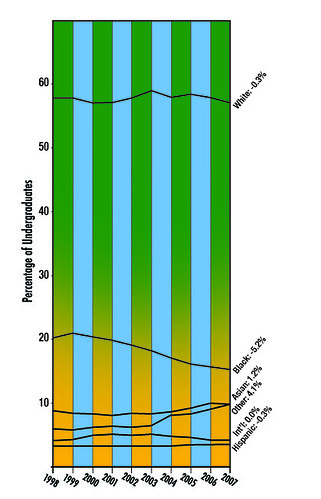Diversity is a goal that many colleges strive for. Ranked as the Princeton Review No. 8 school for diversity, Temple has been ahead of the game.
Though Temple is recognized as a diverse university, student profiles show that ethnic diversity among students has changed over the years.

In the university’s 2005 student profile, African-American students represented 18.7 percent of undergraduate enrollment. Asians ranked as the second highest minority group with 8.7 percent, and Hispanics ranking third at 3.5 percent.
The 2007 student profile shows that African-American and Hispanic enrollment slightly decreased representing 17.3 percent and 3.4 percent, respectively. The Asian population, however, increased to 9.5 percent. White students account for 57.8 percent of undergraduate enrollment.
“I haven’t been to other schools to see what their campus populations look like, but I feel like colleges are either [Historically Black Colleges and Universities] or majority white schools,” said Suzanne Solberg, a sophomore education major. “I don’t feel like there are any in between. I think we’re diverse, but not as much as we could and should be.”
The number of white students enrolled at the university has been nearly 58 percent for the past three years, but percentages for minority enrollment have decreased.
“There are more white students in general applying to college so more are accepted. The question is how to get more African Americans, Hispanics and even American Indians to apply for higher education,” said William Black, the senior vice provost for Enrollment Management at Temple. “The number of African-American, Asian and Hispanic students graduating from high school is rising. For the university to remain its healthy diversity we need to work hard finding these students to encourage them that Temple may be the place for them.”
“I first came to Temple in 1989, and it was quite different in terms of racial and ethnic demographics,” said Terry Rey, associate professor and chair of the religion department. “The black population was much higher then.”
Rey said the decrease of black applicants could be a result of academically rigorous admission standards implemented during David Adamany’s presidency.
Rey said he is proud of Temple’s efforts to expand diversity on campus.
“I believe in the university’s commitment to the local community,” he said. “Diversity is one of the great appeals with this university, and you can use it as a means for learning about the world.”
Diversity on campus is not limited to race and ethnicity, but also geographical location.
A majority of Temple students are from Pennsylvania. In 2005 the undergraduate Pennsylvania residency population was 71 percent. It remained the same in 2007.
“We have an ethical and moral commitment to the Philadelphia community. Our major market is the four county areas of Philadelphia,” Black said.
“There is an increase of urban school popularity,” said Rhonda Brown, assistant vice president for the Office of Multicultural Affairs. “Suburban kids think urban schools are hot right now, so applications are up from suburban schools. Students are applying here who wouldn’t have applied here years ago.”
Temple accepts more students from suburban areas because the suburban applicants are meeting the university’s academic criteria and requirements.
“Suburban schools get better funding, so the test scores are generally higher,” Brown said.
“The Philadelphia school district is not particularly strong but Temple is working along with Mayor Nutter to better the school system,” Black said.
Black said Temple has adopted a new program to development better enrollment strategies.
“This program is a telecounseling effort with [RuffaloCody LLC] to understand the quantitative side of marketing and admissions. Its primary target groups are students representing diversity and academic excellence,” Black said.
“The university’s commitment to access and excellence is our highest priority,” Black said. “We are trying to give opportunities to students from other places to come and experience Temple.”
Taara Savage-El can be reached at taarasavage-el@temple.edu.


Be the first to comment